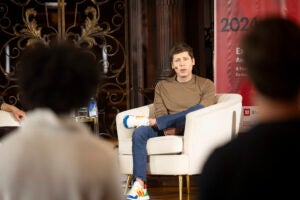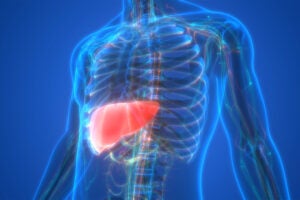Tag: Department of Genetics
-
Health
Seeing double
By comparing the DNA of modern elephants from Africa and Asia to DNA extracted from two extinct species, the woolly mammoth and the mastodon, researchers have concluded that Africa has two — not one — species of elephant. Now that we know the forest and savanna elephants are two very different animals, the forest elephant…

-
Health
Natural flu-fighting protein discovered in human cells
Harvard researchers report having discovered a family of naturally occurring antiviral agents in human cells, a finding that may lead to better ways to prevent and treat influenza and other…
-
Health
Taking a stride toward synthetic life
Harvard scientists have cleared a key hurdle in the creation of synthetic life, assembling a cell’s critical protein-making machinery in an advance with both practical, industrial applications and that advances…
-
Health
Fresh insight into retinitis pigmentosa
Rods and cones coexist peacefully in healthy retinas. Both types of cells occupy the same layer of tissue and send signals when they detect light, which is the first step…
-
Health
Connie Cepko
In some ways, Connie Cepko’s job has gotten easier. The Harvard Medical School genetics professor is working to uncover the mysteries of the eye, to understand how it develops and…
-
Campus & Community
Did ancestral humans, chimps interbreed?
New scientific findings indicate that ancestral humans split from chimpanzee forebears more recently than previously thought and raise the possibility that the two nascent species hybridized before making their final separation.
-
Health
Lab moves genomic testing into the clinic
The earliest symptom of the inherited heart condition hypertrophic cardiomyopathy can be sudden death at a tragically young age. Harvard Medical School researchers discovered the first human gene underlying the…
-
Campus & Community
Bulyk searches for DNA on-off switches
Martha Bulyk held what looked like an ordinary glass slide up to the large window that is much of one wall of her Harvard Medical School office. The slide seemed…
-
Science & Tech
Genome scanning technique spots disease risk
A new technique, admixture mapping, takes advantage of the higher-risk genetic segments from one population that show up in the other through generations of racial mixing. The presence of higher-risk…
-
Campus & Community
Hearing loss tied to heart disease
Two members of a family who suffered progressive hearing loss and then underwent heart transplants got Christine Seidman, a Harvard professor of medicine, interested in the strange connection. Their hearing…
-
Health
RNA-making apparatus seen to uncoil and recoil DNA
Eukaryotic cells like to keep their DNA under wraps, winding the long strands of nucleic acid around millions of little protein complexes. This bead-on-a-string structure, called chromatin, ensures that the…
-
Health
Researchers identify gene’s role in suppressing longevity
SIRT1 is involved in cellular senescence, or limitation of cells’ reproductive lifespan, a process thought to ensure that aging cells don’t pass on harmful mutations. Frederick W. Alt, a Howard…
-
Health
Scientists identify hundreds of worm genes that regulate fat storage
Findings by Harvard researchers, published in the Jan. 16, 2003 issue of Nature, represent the first survey of an entire genome for all genes that regulate fat storage. The research…
-
Health
Formin gene may explain a common cause of female infertility
Harvard Medical School researchers Philip Leder and Benjamin Leader have discovered that oocytes from female mice without the formin gene Fmn2 cannot correctly position the metaphase I DNA-spindle. This produces…
-
Science & Tech
Putting bacteria to work
A nautical group of bacteria known as Prochlorococcus removes carbon dioxide from air and fixes it into the carbon content of their own tiny bodies. The more carbon dioxide they…
-
Health
Resistance mutation found for Gleevec
The drug Gleevec was stunningly successful in treating patients with chronic myelogenous leukemia (CML) at early stages of disease, but quickly stopped working in most patients with more advanced forms…
-
Health
Medical student engineers protein to dissolve blood clots
Heart attacks and strokes are caused by blood clots called thrombi that block blood flow in the arteries of the heart and of the brain. Body tissues become deprived of…
-
Health
Technique enables quick accounting of gene function
Now that whole genomes have been sequenced, a group of scientists has geared up for the next phase: identification and classification of newly discovered coding regions. The DNA microchip, developed…
-
Health
Comprehensive set of vision genes discovered
Using a computer program that compares bits of genetic material taken from tissue in the retinas of mice against records in a huge genetic data base from the mouse and…
-
Health
Anthrax immunity gene found in mice
Anthrax is an often fatal disease that is caused by a bacterium. It has been considered a prime biological weapon in the arsenal of terrorists since attacks in the United…
-
Health
Gene initiates joint formation
Researchers at Harvard Medical School have identified a molecule that plays a central role in the initiation of joint formation. Studying limb formation in the developing chick, postdoctoral fellow Christine…
-
Health
In human genome race, competition spurred better science
The conflicts between the two teams — one publicly funded, one private — that raced to sequence the human genome often drew more attention than the actual completion of the…


